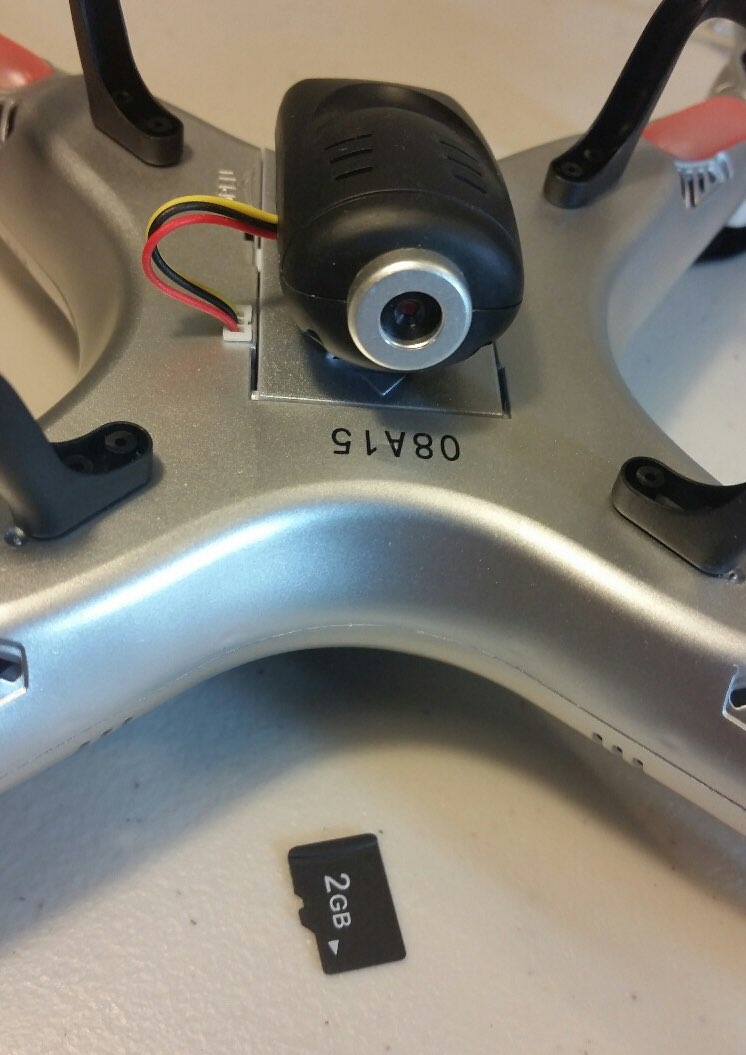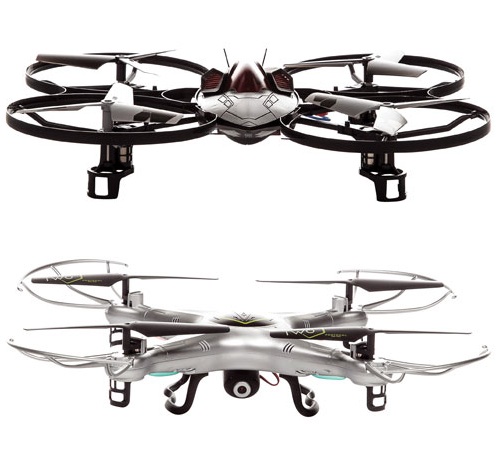
Today is a great day for drone lovers, because today’s review is a 2 for 1 special: You get 2 drone reviews in a single blog! I’ll discuss these drones interchangeably throughout the article, but I’ll always make it clear which one I’m talking about. For the most part I’ll simply refer to them as Manta & Dronium. Their proper names are the Protocol Manta Pro-6 4-Channel RC Quadcopter & the Protocol Dronium Quadcopter Drone with Camera. The Dronium is the bigger of the 2, and it’s also the only one with a camera, which is at least half the fun of these things. On with the reviews!
Initial Impressions
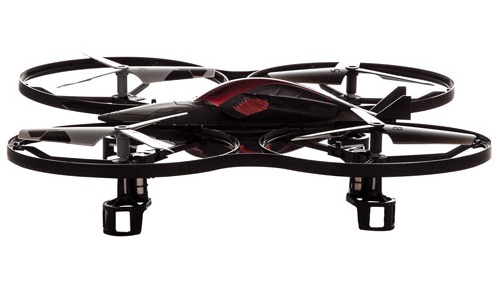 When I first saw the Manta and Dronium Protocol Drones, they were just 2 of 3 drones I received that day, with the third being the larger and more advanced Galileo Drone. This may not have been a good thing, because these 2 smaller drones were somewhat overshadowed by the Galileo. Even so, when I finally got started testing these 2, I was very quickly impressed. The Manta is probably the best looking of the 2, with its stealthy design and black (with red windows) colour scheme. The Dronium is larger, about 1 foot in diameter, and has a nice silver and black (with green accents) colour scheme, but it’s not as sharp as the Manta. Of course, the Dronium more than makes up for this with its precision flying and HD camera!
When I first saw the Manta and Dronium Protocol Drones, they were just 2 of 3 drones I received that day, with the third being the larger and more advanced Galileo Drone. This may not have been a good thing, because these 2 smaller drones were somewhat overshadowed by the Galileo. Even so, when I finally got started testing these 2, I was very quickly impressed. The Manta is probably the best looking of the 2, with its stealthy design and black (with red windows) colour scheme. The Dronium is larger, about 1 foot in diameter, and has a nice silver and black (with green accents) colour scheme, but it’s not as sharp as the Manta. Of course, the Dronium more than makes up for this with its precision flying and HD camera!
Charting the Key Considerations
| How much set up time do these Quadcopters require? | The only set up time for either of these drones is their battery charging times. The Manta takes about 60 minutes to charge and the Dronium takes 75 minutes. You’ll get 7 minutes of flying time for the Dronium and 6 minutes for the Manta (according to their instruction manuals). These are somewhat rough estimates. |
| What type & quantity of batteries do these drones take? | Each of these drones has a built-in rechargeable battery (3.7V / 350mAh for the Manta), and both controllers require 4 X AAs to operate. The battery cover is held in place by 1 screw for each drone. This is somewhat annoying, but at least they give you a screwdriver. |
| What are the mobility (& range) characteristics of these drones? | The Manta Pro-6, though small, can travel at speeds of up to 7.2 Km/h, and it easily got up to 300 feet away from me during testing. I expect that both drones could go even further, but that’s as much space as I had to fly them in. While I found no reference to the Dronium’s top speed, it felt roughly on par with the Manta during testing. |
| Do the Protocol drones feature any special lights & sounds? | The Manta has small, flashing red lights at the bottom front for tracking which way it’s facing during flight, and the Dronium has a pair of red lights (back end) and a pair of green lights (front end) that also help for tracking and night flying. Both drones also make the natural propellers sounds as they fly. |
| What are the suggested age ranges for these drones? | These drones are both intended for use by those 14 and up. As always, I agree with having somewhat higher starting ages for toys that can fly. These things can go really far, and, while they’re not super fast, they’re easy enough to lose track of and may crash into things. Always use the low speed mode when first starting out with one of these drones. All 3 Protocol Drones I’ve tested have multiple speed levels, which is really nice. |
| How much of a WOW factor (on a 0-5 scale) do these drones have? | The Manta scores a 3 / 5 and the Dronium scores a solid 4 / 5, thanks mostly to its included HD camera and its ease of control versus the Manta. The camera really adds considerably to the fun factor here, and it is missed on the Manta. See below in the Mini Gallery for a close up shot of the camera & its SD chip. |
Testing & Play
To test these drones require several visits to a couple of local parks. As always with toys that fly, a good bit of open space is necessary, even though the Manta is classified as an indoor / outdoor model. By some miracle, I lost neither of these copters in a tree—a first for me! We’ll discuss flight performance individually, beginning with the Manta.
Manta Pro-6 Quadcopter
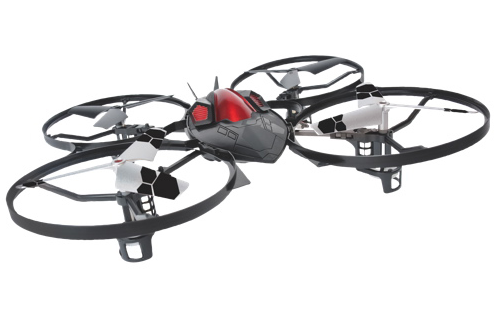 The Manta Pro-6 is a 4.5-Channel RC Quad-Copter, and it’s also the more erratic and wild of the 2 drones to fly. Even though the Manta is somewhat difficult to control, it can fly very high and very far away, and it’s a whole lot of fun to use. One thing that I think affects one’s ability to control the Manta is the fact that it’s so hard to see its directional indicator lights when it gets more than about 50 feet or so away, so you can’t exactly tell which way it’s facing, and this leads to confusion on the controls. It also is easily lost (visually) among trees and even power lines. When it’s about 100 feet away and 50 (or so) feet in the air, it just looks like a thin black line. As soon as you fly in front of anything other than clear blue sky, you can no longer see the Manta. It’s just so small… Finally, the Manta is fast—probably the fastest of the 3 Protocol Drones I have tested, which makes it all the more difficult to rein in.
The Manta Pro-6 is a 4.5-Channel RC Quad-Copter, and it’s also the more erratic and wild of the 2 drones to fly. Even though the Manta is somewhat difficult to control, it can fly very high and very far away, and it’s a whole lot of fun to use. One thing that I think affects one’s ability to control the Manta is the fact that it’s so hard to see its directional indicator lights when it gets more than about 50 feet or so away, so you can’t exactly tell which way it’s facing, and this leads to confusion on the controls. It also is easily lost (visually) among trees and even power lines. When it’s about 100 feet away and 50 (or so) feet in the air, it just looks like a thin black line. As soon as you fly in front of anything other than clear blue sky, you can no longer see the Manta. It’s just so small… Finally, the Manta is fast—probably the fastest of the 3 Protocol Drones I have tested, which makes it all the more difficult to rein in.
Dronium Quadcopter
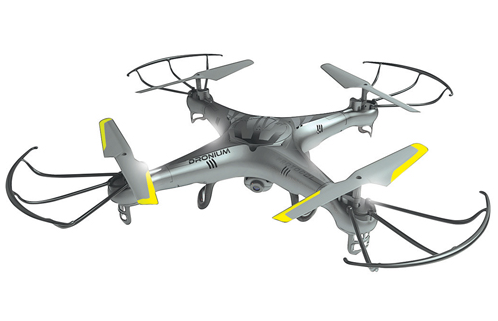 The Dronium is a 4-Channel Radio Controlled Quad-Copter, and it’s an absolute pleasure to fly. I found that flying this copter was very similar to flying the Protocol Galileo Drone that I reviewed last week, and their controllers are virtually identical as well (other than this one being scaled down a bit and having a screw down battery cover). In fact, even the Manta shares the same controller design (I’ll cover the functionality of both below). My favourite thing about the Dronium, though, is the semi-permanently attached HD camera on its underbelly. I was able to take some really fun video footage with this camera—much of which appears in the Dronium’s supplemental video review below. It is also worth noting that the Dronium charges via a USB charger directly from your computer, which is different from the larger Galileo.
The Dronium is a 4-Channel Radio Controlled Quad-Copter, and it’s an absolute pleasure to fly. I found that flying this copter was very similar to flying the Protocol Galileo Drone that I reviewed last week, and their controllers are virtually identical as well (other than this one being scaled down a bit and having a screw down battery cover). In fact, even the Manta shares the same controller design (I’ll cover the functionality of both below). My favourite thing about the Dronium, though, is the semi-permanently attached HD camera on its underbelly. I was able to take some really fun video footage with this camera—much of which appears in the Dronium’s supplemental video review below. It is also worth noting that the Dronium charges via a USB charger directly from your computer, which is different from the larger Galileo.
Controllers

As I mentioned above, the controllers (transmitters) for both drones are virtually identical. They’re both 2.4 GHz, and are laid out in the same format. The one shown at right belongs to the Dronium. The Manta’s is shown in the Mini Gallery below. The main controls to be aware of are the left and right joysticks. The left joystick controls lift-off and landing, as well as turning the drones to whatever direction you prefer. The right joystick actually moves you forward, backward, and side to side while flying. For the Dronium, the camera button is just to the right of the left joystick. The same button on the camera-less Manta is for fine tuning your throttle output. For both controllers, a stunt flying button is at the top right corner of the controller (along the outer edge), and an LCD display is located front and center (at the bottom of the controller). An oval power indicator light also appears in the center of each controller (near the top, roughly half way between the aerial and the On / Off switch, which itself is pretty much dead center of the controller). The small button along the top left corner (outside edge of the controller) allows you to choose between the high and low speed settings. Both controllers are fairly intuitive to use, so if you get used to using either, you’re in good shape for using both.
For & Against
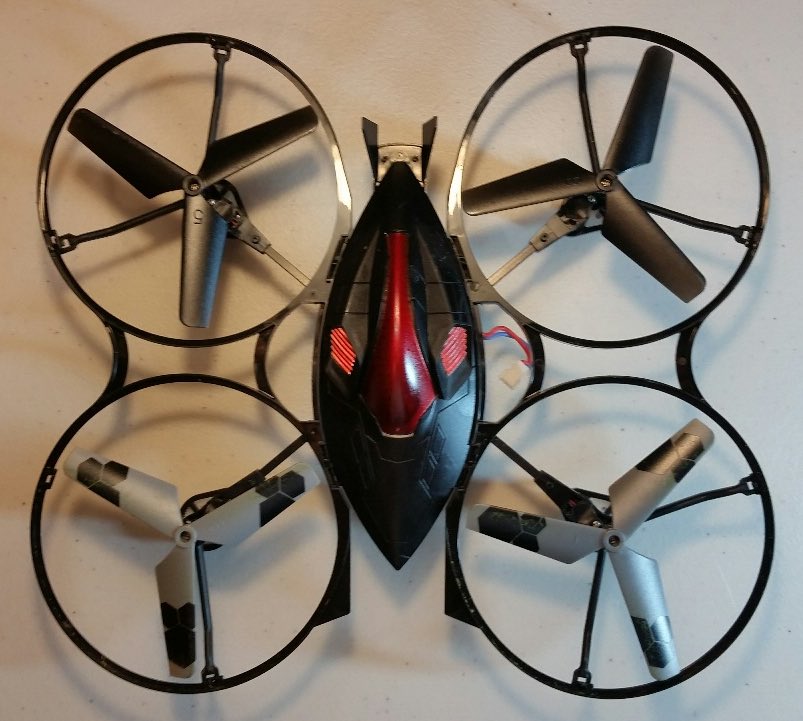
The best thing about the Manta Pro-6 Quadcopter Drone is that for a very small drone (one that’s classified as for indoor or outdoor use), it has a very good range, just like its bigger brother. I wouldn’t have expected the Manta to be able to fly as far away as it can, which is at least 200-300 feet (and maybe further).
The best thing about the Dronium Quadcopter is the fact that it has a camera (see below) that takes good quality photos and video. The 2GB SD card that’s included has only half the storage space of the Protocol Galileo Drone’s SD chip (the drone I reviewed last week), but even so, it still holds up to 800 photos or 20 minutes of video, meaning you’ll run out of battery power long before you ever fill the chip!
 The biggest drawback to the Manta is that there is no obvious way to remove the rechargeable battery, so if (or when) it dies for good, you won’t be able to change it—at least not easily. I expect I could get it out if I was really determined, but there’s no clear way of doing so, and I certainly don’t want to crack into it like a chestnut. Another drawback to the Manta is that it’s just not as easy to control as the Dronium. I’m not saying it’s a major issue, and it’s probably to be expected in a model that’s only about half the cost of the higher level Dronium, but it is a bit erratic, and I just couldn’t fly it as well as either of the bigger Protocol Drones.
The biggest drawback to the Manta is that there is no obvious way to remove the rechargeable battery, so if (or when) it dies for good, you won’t be able to change it—at least not easily. I expect I could get it out if I was really determined, but there’s no clear way of doing so, and I certainly don’t want to crack into it like a chestnut. Another drawback to the Manta is that it’s just not as easy to control as the Dronium. I’m not saying it’s a major issue, and it’s probably to be expected in a model that’s only about half the cost of the higher level Dronium, but it is a bit erratic, and I just couldn’t fly it as well as either of the bigger Protocol Drones.
The biggest drawback to the Dronium is… well, I’m not so sure it has one. It’s actually quite impressive. It flies really well & has a nice camera. What’s not to like?
Examining the Video Evidence
Please check out my video review of the Protocol Dronium Quadcopter Drone:
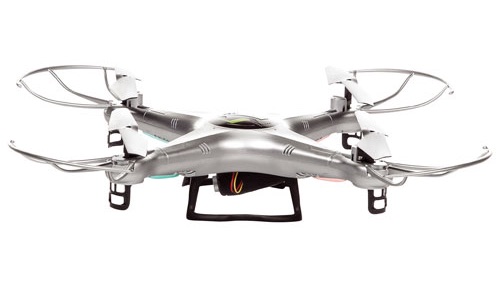 Final Thoughts
Final Thoughts
My final verdict is this: Both of these drones are worth picking up, and your choice should mostly depend on your budget. The Dronium is the more expensive of the 2, by nearly double, but if you enjoy the photo and video aspect of flying drones (and the Dronium is within your budget), then this is the one I would choose. If it’s just some good flying fun you’re looking for, you really can’t go wrong with either of these toys, but again, the Dronium is the easier model to control. Whichever drone you decide on, happy flying!
Mini Gallery of Additional Photos
